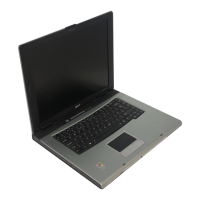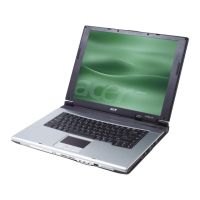Do you have a question about the Acer TravelMate 210 and is the answer not in the manual?
Overview of the computer's key features.
Illustrates the computer's internal hardware architecture and connections.
Details the physical arrangement of components on the motherboard's top view.
Describes ports and indicators on front, left, right, rear, and bottom panels.
Explains the function of the computer's status indicator lights.
Details keyboard, hot keys, and touchpad functionality.
Lists detailed technical specifications for major hardware components.
Explains the system's power saving modes and features.
Details mechanical specs, memory map, I/O addresses, IRQ, and DMA assignments.
Guides on accessing and navigating the BIOS Setup Utility.
Displays a summary of the computer's hardware configuration.
Covers date/time, boot sequence, security, and default settings.
Provides instructions for updating the system's BIOS firmware.
Explains utilities for panel ID, thermal/fan, and motherboard data.
Details diagnostic tools for hardware testing like PQA, Audio, and USB.
Lists necessary tools and initial steps before disassembling the computer.
Provides a graphical overview of the component removal sequence.
Step-by-step guide for removing battery, CD-ROM, and HDD modules.
Instructions for removing memory, modem, and PCMCIA slot.
Detailed procedures for disassembling various parts of the LCD assembly.
Steps for removing upper case, lower case, and main board.
Guides for checking diskette, CD-ROM, keyboard, memory, power, and touchpad.
Lists BIOS error messages and their corresponding actions.
Troubleshooting steps for issues without audible or visible error codes.
General procedure and guidelines for diagnosing computer problems.
Cross-references symptoms to possible FRU replacements.
Steps for diagnosing and resolving issues that occur sporadically.
Procedures for isolating failing FRUs when the cause is unclear.
Maps PQA diagnostic error codes to their meanings and actions.
Identifies jumpers and connectors on the top view of the motherboard.
Details keyboard switch settings and SW-4/5 configurations.
Identifies jumpers and connectors on the bottom view of the motherboard.
Provides guidelines for ordering replacement parts and RMA procedures.
Lists FRUs with part numbers for memory, LCD, drives, and other components.
Details different notebook models and their configurations.
Explains Acer's internal testing process for system compatibility.
Lists components verified for compatibility in Windows Me environments.
Information on accessing Acer's online technical support resources.











